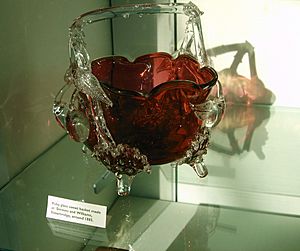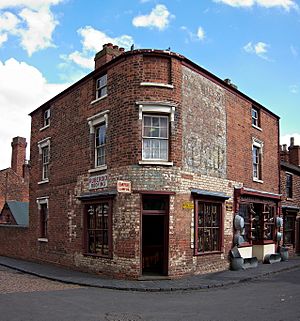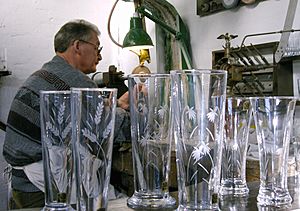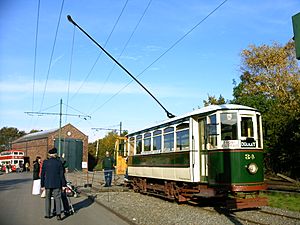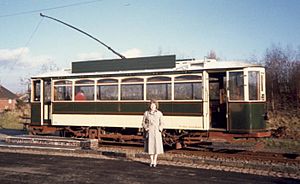Black Country Living Museum facts for kids

The main village street and 1930s area
|
|
| Lua error in Module:Location_map at line 420: attempt to index field 'wikibase' (a nil value). | |
| Established | 1975 |
|---|---|
| Location | Dudley, West Midlands |
| Type | Open-air living museum |
The Black Country Living Museum is a special place in Dudley, England. It's an open-air museum where you can step back in time! The museum has many old buildings that were moved here and rebuilt. It shows what life was like in the Black Country area, especially between 1850 and 1950.
The museum opened in 1978. Since then, it has added over 50 shops, houses, and other buildings. These buildings came from towns like Dudley, Sandwell, Walsall, and Wolverhampton. They were carefully taken apart and put back together here. This creates a real-life village where you can see history come alive. People dressed in old clothes show you how things were done long ago. The museum is always growing, with new exhibits being added.
Contents
Discovering the Black Country's Past
This museum is in the heart of the Black Country. This area is famous for its history in making iron and steel. It's even called "the birthplace of the Industrial Revolution". Long ago, people here learned to make iron using coal instead of wood. This helped create many metal products, from small nails to huge anchor chains for ships like the RMS Titanic.
At the museum, you can explore old coal mines. You can also see a working copy of a Newcomen steam engine. This amazing machine was invented in 1712 to pump water out of mines. It was a very important invention!
You can ride old electric trams and trolleybuses around the museum. They take you from the entrance to the main village. On the way, you'll see unique cast iron houses and a fun 1930s fairground. You can even take a boat trip into the Dudley Canal and Dudley Tunnel. In 2012, the museum's collection was given a special award. This shows how important it is for the country's history. The museum is run by a charity called the Black Country Living Museum Trust.
Exploring the Museum's Collections
Near the entrance, you'll find displays of local items. These show the many things made in the Black Country. You can see metal pots, animal traps, chains, anchors, and even beautiful glass items. The area was known for making fine crystal glass for hundreds of years.
Coal Mining and Lime Kilns
The museum site used to have 42 old mine shafts. Two of them are now preserved. In 1712, Thomas Newcomen built the first successful steam engine. It was used to pump water from coal mines. The museum built a working copy of this engine in 1986. You can see how this "fire engine" used steam to power pumps and remove water from the mine.
People also worked with lime on this site for a very long time. You can see old quarries and lime kilns. These kilns were used to process limestone. The oldest of the three kilns you see today is from the late 1700s.
Metal Working Shops
The museum has many workshops that show how metal items were made.
- Trap Shop: This shop was built in 1913 and moved to the museum in 1982. It shows how animal traps were made around the 1930s.
- Nail Shop: This is a copy of a small workshop from the 1880s. You can watch a nail maker use old tools to forge nails by hand.
- Brass Foundry: Built in 1869, this workshop shows how brass items were cast. You might see a brass caster making horse brasses or other small items.
- Rolling Mill: This large machine was used to flatten metal. It was moved to the museum in 1976. Sometimes, volunteers show how it works.
- Anchor Forge: This is where parts for huge ship anchors were made. It has a steam-powered hammer from the 1920s.
- Chain Maker's Shop: This workshop shows how chains were made by hand. You can watch chain makers at work every day.
- Machine Shop: This shop had special hammers called Oliver hammers. They were used to make bolts and other parts.
The Historic Village
At one end of the museum, there's a village from the early 1900s. Houses, shops, and other buildings were moved here brick by brick. Staff in old costumes show you what life was like.
You can visit different shops:
- Gregory's General Store: A classic old-fashioned shop.
- Emile Doo's Chemist Shop: An old pharmacy.
- Sweet Shop and Cake Shop: With a bakery in the back!
- Hardware and Ironmongers Shop: From Wolverhampton.
- Pawnbroker's Shop: Moved to the museum in 1991.
You can also see homes like the back-to-back houses from the 1850s. These were small homes for workers. The anchor maker's house was one of the first homes moved to the museum.
Important public buildings include:
- Providence Chapel: One of the first buildings rebuilt here.
- Bottle and Glass Inn: A working pub set up like it was in 1910.
- Village Postbox: An old postbox from London, designed in 1865.
- Carter's Yard: A yard from around 1900, moved here in the 1990s.
1930s Street (Old Birmingham Road)
This street shows what life was like in the 1930s, just before World War II.
- St James's School: Museum staff show lessons from the early 1900s. The school building was moved here in 1990.
- Hobbs & Sons Fish and Chip Shop: This shop looks like it did in 1935. It has beautiful old tiled walls.
- H Morrall's Gentlemen's Outfitters: An old clothing shop.
- Humphrey Brothers: A builders' merchant shop from the 1930s.
- Motorcycle Shop: Displays old motorbikes made between 1929 and 1934.
- Alfred Preedy & Sons Tobacconist Shop: An old tobacco shop.
- James Gripton's Radio Shop: This shop is set in 1939 and has old radios.
You can also see a 1930s kitchen with an electric cooker. Upstairs, there are living rooms and bedrooms furnished with items from the 1930s.
Cradley Heath Workers' Institute
This special building was built in 1912. It was funded by money left over from a strike by women chain makers in 1910. It was a place for meetings and social events. The building honors Mary Macarthur, who fought for fair wages for workers. Inside, you can learn about the strike and see a large hall used for shows and concerts.
1930s Fairground
This fairground shows what a traveling fair was like in the early 1900s. These fairs brought fun and excitement to towns. You can ride historic rides like a helter skelter and "The Ark." The Ark was a fast ride from the 1920s.
Lord Ward's Canal Arm
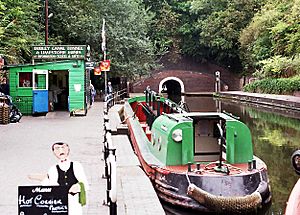
The museum has a boat dock that looks like ones used on the Birmingham Canal Navigations. These docks were used to build and fix wooden and iron boats. Next to the museum is the Dudley Tunnel. You can take a boat trip into the tunnel and see the old limestone mines.
Museum Boat Collection
The museum has many historic boats. Some are owned by the museum, and others are on loan.
- Prosper
- Edna Irene
- Admiral Beatty
- Warehouse (GKN14)
- Ham
- Amp (GWR 19)
- Stewarts and Lloyds 100
- Matty Butty
- North Star II
- Diamond
- Bessie
- Eustace
- President
- Kildare
- Stour
- Birchills
Other boats at the museum include:
- District Number 1
- Peacock
- Coventry
- GWR 15
- BHP 2
- FMC 138
- BHP 3
- Ross
Transport Collection
The museum has many old vehicles that were used or made in the Black Country.
Trams
You can ride on some of the museum's historic trams.
- Dudley, Stourbridge and District Electric Traction Company No. 5: Built in 1920, this was the museum's first tram.
- Wolverhampton District Electric Tramways Company No. 19: A works car from 1902, waiting to be restored.
- Wolverhampton Tramways Company Horse Tram No. 23: The museum's oldest tram, built in 1892.
- Wolverhampton District Electric Tramways Company No. 34: Built in 1919, it worked at the museum for 20 years.
- Wolverhampton Corporation Tramways No. 49: A double-decker from 1909, now in service.
- Dudley, Stourbridge and District Electric Traction Company No. 75: Built in 1919, waiting to be restored.
- Wolverhampton Corporation Tramways No. 102: Built in 1920, used as a tram shelter before restoration.
Motor Buses
The museum also has old motor buses.
- West Bromwich Corporation Daimler CVG6 GEA 174: Built in 1948, now working.
- Midland Red BMMO D9 6342 HA: Built in 1963, now working.
- Guy Motors KTT 689: Built in 1948, now working.
- West Bromwich Corporation Dennis E-Type EA 4181: Built in 1929.
Trolleybuses
On certain days, you can ride a trolleybus. These are buses that get their power from overhead electric lines. The museum has three trolleybuses from the Black Country's past.
- Wolverhampton Corporation Transport 78: A Guy trolleybus from 1931, needs restoration.
- Wolverhampton Corporation Transport 433: A Sunbeam from 1946, now working.
- Bradford Corporation Transport 735: A Karrier from 1946. It's painted to look like a Walsall trolleybus. Now working.
- Walsall Corporation Transport 862: A Sunbeam from 1955, now working.
Motor Cars
The Black Country was home to early car makers like Sunbeam and Star. The museum has a 1903 Sunbeam, a 1912 Star, and a 1931 AJS. You can also see newer cars like the Kieft, Frisky, and Westfield Topaz.
Motorcycles
The museum has about 40 motorcycles. All of them were made in the Black Country. Many are from Sunbeam and AJS. There are also bikes from other companies like Wearwell and Rockson.
Other Vehicles
The museum also has other interesting vehicles. These include a 1924 Guy fire engine and a Model T Ford van. There's also a Bean flatbed truck from Tipton.
Other Collections
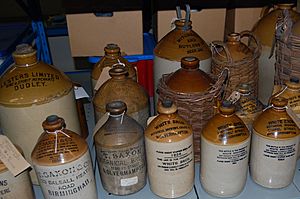
Besides what's on display, the museum has many other items stored away. These include old objects, historical papers, and books. You can see them by making an appointment.
Filming Location
The museum is a popular place for filming movies and TV shows. It was used for Rosie & Jim, WPC 56, and Peaky Blinders. Parts of the movie Stan & Ollie were also filmed on the 1930s Street.
Future Plans for the Museum
In 2017, the museum received a large grant to expand. This project, called BCLM: Forging Ahead, was planned to be finished in 2022. It will help the museum tell the story of the Black Country up to 1968. New buildings will be added, like Wolverhampton's Elephant & Castle pub, a newsagent, a hairdressers, and a library. This expansion will make the museum one-third bigger!
See also
- Blists Hill Victorian Town
- Beamish Museum
- Avoncroft Museum of Historic Buildings
- Summerlee Heritage Park
- Ulster Folk and Transport Museum
- St Fagans National History Museum
- Sovereign Hill
Images for kids
-
Early Sunbeam motor car.
-
A trolleybus at the museum
-
Trolleybuses at the museum. The rear (dark green and cream) vehicle is from Derby and the front (light green and yellow) vehicle is from Wolverhampton. The red bus in the distance is a BMMO motor bus.
-
Exhibition Hall: the iron trusses are from the former Rolfe Street public baths, Smethwick, built 1888, designed by Harris, Martin & Harris
Getting to the Museum
The closest train station is Tipton railway station. From there, you can take the 229 bus service. Bus services 11/11A and Diamond Bus service 229 also pass the museum regularly. An extension to the Midland Metro tram system is being built. It will have a stop near the museum.



